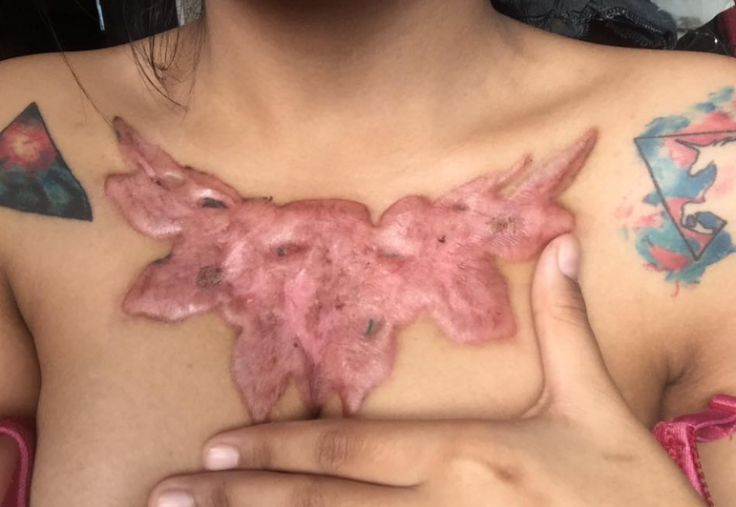Chemical Tattoo Removal Cream Makes Student's Skin Fall Off, Leaving Her With Horrible Scar

Update: A previous version of this article incorrectly stated Pasuda Reaw used a Rejuvi Laboratory product to remove her tattoo. This has been corrected.
A 21-year-old college student in Thailand was left with a horrific scar and an even worse story after a chemical tattoo removal process caused her skin to blister and “fall off.” Three months later, the wound where the tattoo once existed has still not healed, and the student now has a raw raised chemical burn.
Tattoo removal is never easy, but the aftermath of Pasuda Reaw’s chemical tattoo removal process is just plain gruesome. Reaw, a student at Udon Thani University in Thailand, decided to have her chest tattoo removed using a chemical erasing process. Reaw first tried the chemical tattoo process in February of this year, and now three months later she is still left with a very large scar from the process.
Read: Laser Tattoo Removal Before and After: What It’s Like To Erase Your Ink
"I did not want to use lasers," explained Reaw, The Daily Mail reported. "I began the treatment and immediately it was itchy and hurting a lot. The skin has taken a long time to come off. It was like torture and I could not sleep."
“What is left is worse than before. I do not recommend this treatment because it hurts so bad and takes a long time,” she added.
According to Reaw, after the chemical cream was applied to her tattoo, she found it hard to sleep due to the intense stinging feeling from her chest. About 10 days after the initial application, the skin of her tattoo started to fill with pus and peel. By March 2, she was able to completely peel off the tattoo skin, revealing a large pink and sensitive scar underneath. Reaw hopes that sharing her ordeal and photos of her scarred skin, will help other think twice about their tattoo removal process.
Reaw is not the first person to experience a bad reaction to chemical tattoo removal techniques, and in 2015, Andrea Catton Laser Clinic, a laser tattoo removal clinic in the UK, said the process can lead to side effects such as pain, bruising, swelling, itching, scabbing, discoloration, infection, and permanent scarring.
Lazer tattoo removal remains the most common route of getting rid of unwanted skin ink. The process involves using an ultra-short laser to break up the ink molecules in the skin. Once broken up, the body’s immune system then carries away this ink, taking it to the liver where it is eventually completely disposed of, Smarter Everyday reported.
See Also:
Tattoo Regret: Why The Majority Of Middle-Aged Americans Are Deciding To Blast Away Their Ink
Laser Tattoo Removal Breaks Up Ink Droplets For White Blood Cells To Carry Away



























